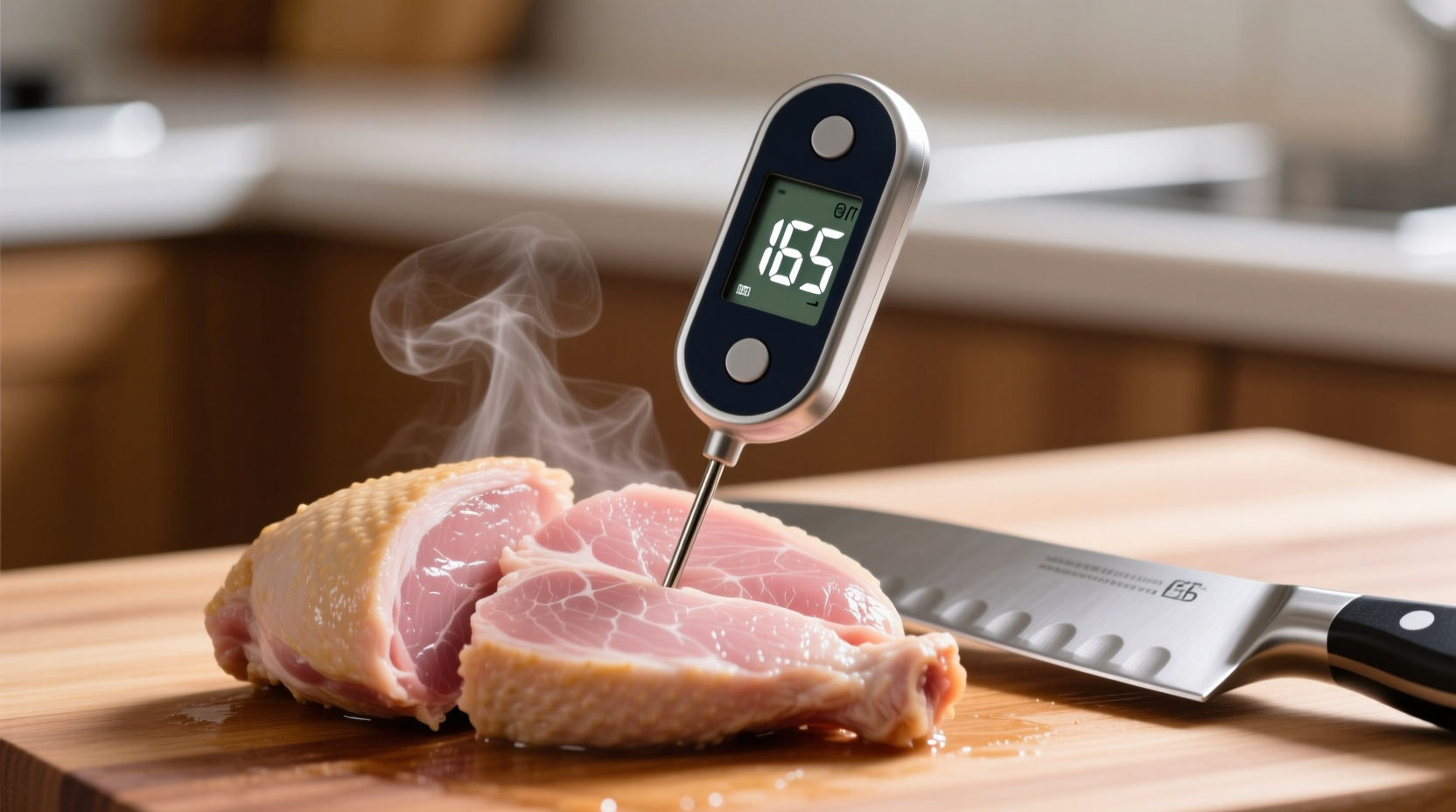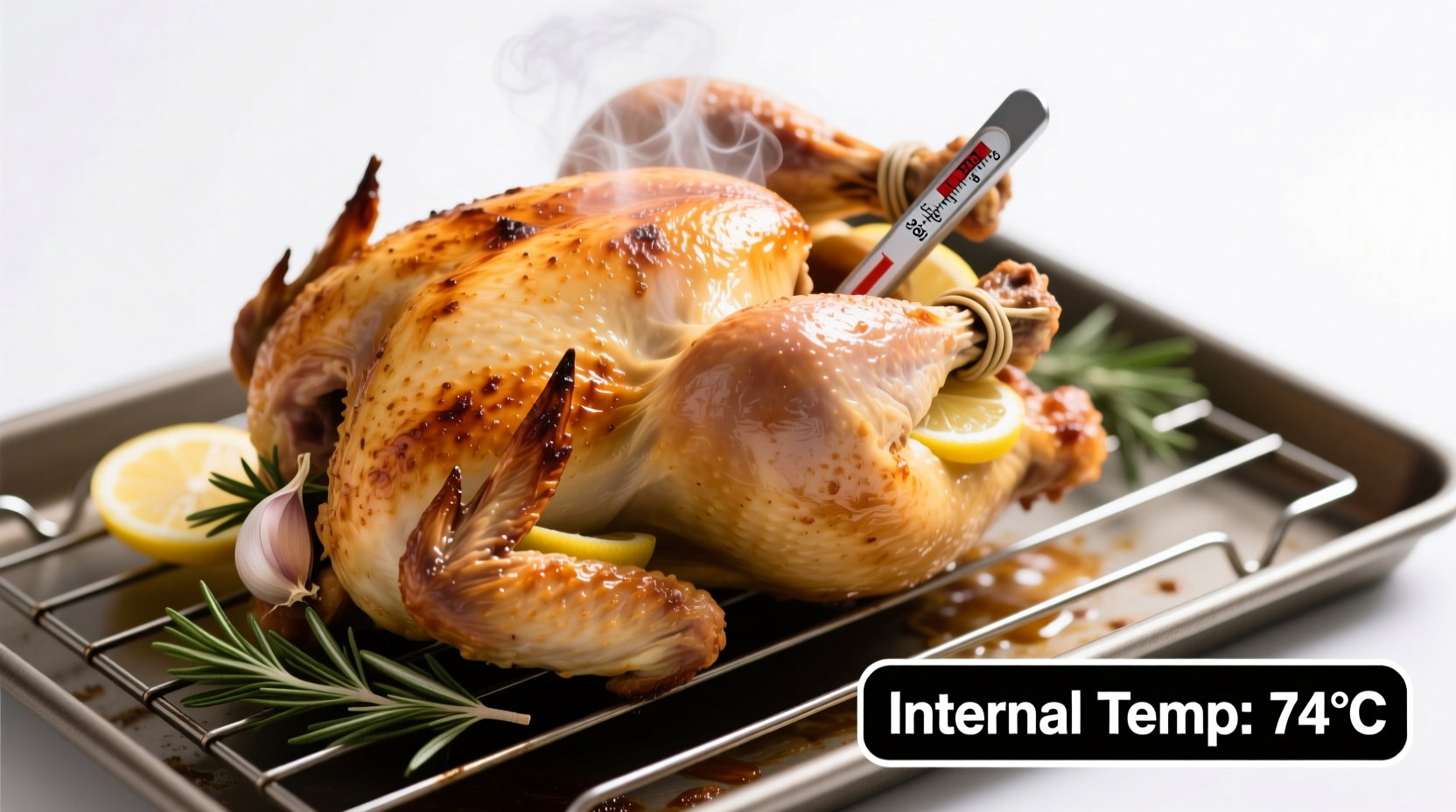The safe internal temperature for a fully cooked whole chicken is 165°F (73.8°C) as measured in the thickest part of the breast and inner thigh, according to USDA Food Safety and Inspection Service guidelines. This temperature destroys harmful bacteria like salmonella while maintaining optimal juiciness.
Why Chicken Temperature Matters More Than You Think
When roasting a whole chicken, hitting the right temperature isn't just about doneness—it's your primary defense against foodborne illness. Unlike steak where surface bacteria are the main concern, poultry requires thorough internal heating because harmful pathogens like Salmonella and Campylobacter can permeate muscle tissue. The USDA's 165°F standard represents the precise threshold where these bacteria are instantly destroyed, providing a critical safety margin for home cooks.
How to Measure Chicken Temperature Like a Pro
Many home cooks make critical errors when checking chicken temperature. Follow these professional techniques:
- Use an instant-read thermometer: Digital thermometers provide accuracy within ±1°F—critical when cooking poultry
- Check multiple spots: Insert probe into the thickest part of breast, inner thigh (avoiding bone), and wing joint
- Wait 15 seconds: Allow time for the reading to stabilize before recording
- Calibrate regularly: Test in ice water (should read 32°F/0°C) or boiling water (212°F/100°C)
"A properly calibrated thermometer is your most important kitchen tool for poultry safety," explains Antonio Rodriguez, culinary expert with Michelin-starred kitchen experience. "Visual cues like clear juices or firm texture are unreliable indicators—only temperature guarantees safety."
USDA vs. FDA Temperature Standards: What You Need to Know
While the USDA sets the definitive standard for home cooking, commercial kitchens follow slightly different guidelines. This comparison clarifies the distinctions:
| Organization | Required Temperature | Holding Time | Applicable Setting |
|---|---|---|---|
| USDA Food Safety and Inspection Service | 165°F (73.8°C) | Instant | Home kitchens, retail |
| FDA Food Code | 165°F (73.8°C) | 15 seconds | Commercial kitchens |
| Cornell University Food Science | 160°F (71°C) | 14.8 seconds | Research context only |
Source: USDA Food Safety and Inspection Service
Complete Cooking Time Guide by Weight and Method
While temperature is the definitive doneness indicator, these time estimates help with meal planning. Always verify with a thermometer regardless of cooking time.
| Chicken Weight | Oven Temperature | Approximate Cooking Time | Resting Time |
|---|---|---|---|
| 3-4 lbs (1.4-1.8 kg) | 375°F (190°C) | 60-75 minutes | 15 minutes |
| 4-5 lbs (1.8-2.3 kg) | 375°F (190°C) | 75-90 minutes | 20 minutes |
| 5-6 lbs (2.3-2.7 kg) | 375°F (190°C) | 90-120 minutes | 25 minutes |
Source: National Center for Home Food Preservation
The Critical Resting Period: What Happens After Cooking
Many home cooks make the mistake of carving immediately after removing chicken from heat. The 15-25 minute resting period serves three vital functions:
- Temperature equalization: Heat redistributes from outer layers to center, ensuring even doneness
- Juice retention: Muscle fibers relax, preventing valuable moisture from escaping during carving
- Carryover cooking: Internal temperature typically rises 5-10°F during resting, helping reach optimal doneness
"Resting isn't optional—it's part of the cooking process," emphasizes Rodriguez. "Cover loosely with foil to maintain heat without steaming the skin. This is when the magic happens for juicy, flavorful chicken."
Stuffing Safety: A Temperature Complication
While stuffing a whole chicken creates delicious flavor, it introduces significant food safety concerns. The stuffing must also reach 165°F internally, which often requires:
- Cooking the stuffing separately to ensure safety
- Using a separate thermometer to check stuffing temperature
- Allowing additional 20-30 minutes cooking time when stuffed
- Immediately removing stuffing after cooking to prevent bacterial growth
The USDA strongly recommends cooking stuffing separately for optimal safety, as the dense center often lags behind the chicken's temperature.
Avoid These Common Temperature Mistakes
Even experienced cooks sometimes fall into these temperature traps:
- Checking too early: Opening the oven frequently drops temperature and extends cooking time
- Touching bone: Bone conducts heat differently, giving false high readings
- Ignoring carryover: Removing chicken too early because it hasn't reached 165°F yet
- Single-point testing: Only checking one spot instead of multiple critical areas
Professional kitchens use temperature logs to track cooking progress—consider adopting this practice for perfect results every time.
Visual Indicators That Support Temperature Readings
While temperature is definitive, these visual cues should accompany your thermometer reading:
- Juices run clear (not pink) when thigh is pierced
- Legs move freely in their joints
- Meat is opaque with no translucent areas
- Skin is golden brown and crisp
Remember: These signs support—but don't replace—temperature verification. Undercooked chicken can still show these characteristics.

Troubleshooting Temperature Issues
When your chicken isn't reaching proper temperature:
- Undercooked after estimated time: Return to oven and check every 10 minutes
- Overcooked despite proper temperature: Try brining next time for moisture retention
- Uneven cooking: Rotate pan halfway through cooking or use a convection setting
- Temperature plateau: Wrap breast area with foil to prevent overcooking while thigh continues heating
For consistently perfect results, invest in an oven thermometer to verify your oven's actual temperature—many home ovens run 25°F hotter or cooler than indicated.











 浙公网安备
33010002000092号
浙公网安备
33010002000092号 浙B2-20120091-4
浙B2-20120091-4